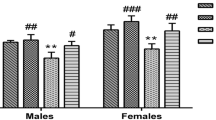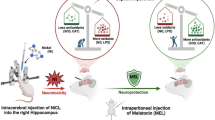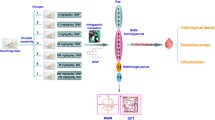Abstract
Diazinon is an organophosphorous pesticide with a prominent toxicity on many body organs. Multiple mechanisms contribute to diazinon-induced deleterious effects. Inhibition of acetyl-cholinesterase, cholinergic hyperstimulation, and formation of reactive oxygen species may play a role. On the other hand, melatonin is a pineal hormone with a well-known potent antioxidant activity and a remarkable modulatory effect on many behavioral processes. The present study revealed that oral diazinon administration (25 mg/kg) increased anxiety behavior in rats subjected to elevated plus maze and open-field tests possibly via the induction of changes in brain monoamines levels (dopamine, norepinephrine, and serotonin). Additionally, brain lipid peroxides measured as malondialdehyde (MDA) and tumor necrosis factor alpha (TNF-α) levels were elevated, while the activity of brain glutathione peroxidase enzyme was reduced by diazinon. Co-administration of oral melatonin (10 mg/kg) significantly attenuated the anxiogenic activity of diazinon, rebalanced brain monoamines levels, decreased brain MDA and TNF-α levels, and increased the activity of brain glutathione peroxidase enzyme.




Similar content being viewed by others
References
Kamanyire R, Karalliedde L (2004) Organophosphate toxicity and occupational exposure. Occup Med 54:69–75
Roegge CS, Timofeeva OA, Seidler FJ, Slotkin TA, Levin ED (2008) Developmental diazinon neurotoxicity in rats: later effects on emotional response. Brain Res Bull 75:166–172
Cakici O, Akat E (2013) Effects of oral exposure to diazinon on mice liver and kidney tissues: biometric analyses of histopathologic changes. Anal Quant Cytol Histol 35:7–16
Gokcimen A, Gulle K, Demirin H, Bayram D, Kocak A, Altuntas I (2007) Effects of diazinon at different doses on rat liver and pancreas tissues. Pestic Biochem Physiol 87:103–108
Okamura A, Kamijima M, Ohtani K, Yamanoshita O, Nakamura D, Ito Y, Miyata M, Ueyama J, Suzuki T, Imai R, Takagi K, Nakajima T (2009) Broken sperm, cytoplasmic droplets and reduced sperm motility are principal markers of decreased sperm quality due to organophosphorous pesticides in rats. J Occup Health 51:478–487
Cavari Y, Landau D, Sofer S, Leibson T, Lazar I (2013) Organo-phosphate poisoning-induced acute renal failure. Pediatr Emerg Care 29:646–647
Devinsky O, Kernan J, Bear DM (1992) Aggressive behavior following exposure to cholinesterase inhibitors. J Neuropsychiatry Clin Neurosci 4:189–194
Jayasinghe SS (2012) Effects of acute organophosphate ingestion on cognitive function, assessed with the mini mental state examination. J Postgrad Med 58:171–175
Win-Shwe TT, Nakajima D, Fujimaki H (2012) Involvement of TLR4 in diazinon-induced neurotoxicity in mice. J UOEH 34:1–13
Uner N, Sevgiler Y, Durmaz H, Piner P, Cinkiloğlu E (2009) N-Acetylcysteine provides dose-dependent protection against fenthion toxicity in the brain of Cyprinus carpio L. Comp Biochem Physiol C Toxicol Pharmacol 150:33–38
Amara IB, Soudani N, Troudi A, Hakim A, Zeghal KM, Boudawara T, Zeghal N (2012) Dimethoate induced oxidative damage and histopathological changes in lung of adult rats: modulatory effects of selenium and/or vitamin E. Biomed Environ Sci 25:340–351
Hariri A, Moallem S, Mahmoudi M, Memar B, Hosseinzadeh H (2010) Sub-acute effects of diazinon on biochemical indices and specific biomarkers in rats: protective effects of crocin and safranal. Food Chem Toxicol 48:2803–2808
Al-Omary FA (2013) Melatonin: comprehensive profile. Profiles Drug Subst Excip Relat Methodol 38:159–226
Quera Salva MA, Hartley S (2012) Mood disorders, circadian rhythms, melatonin and melatonin agonists. J Cent Nerv Syst Dis 4:15–26
Bavithra S, Selvakumar K, Krishnamoorthy G, Venkataraman P, Arunakaran J (2013) Melatonin attenuates polychlorinated biphenyls induced apoptosis in the neuronal cells of cerebral cortex and cerebellum of adult male rats-in vivo. Environ Toxicol Pharmacol 36:152–163
Hashimoto K, Ueda S, Ehara A, Sakakibara S, Yoshimoto K, Hirata K (2012) Neuroprotective effects of melatonin on the nigrostriatal dopamine system in the zitter rat. Neurosci Lett 506:79–83
Tchekalarova J, Petkova Z, Pechlivanova D, Moyanova S, Kortenska L, Mitreva R, Lozanov V, Atanasova D, Lazarov N, Stoynev A (2013) Prophylactic treatment with melatonin after status epilepticus: effects on epileptogenesis, neuronal damage, and behavioral changes in a kainate model of temporal lobe epilepsy. Epilepsy Behav 27:174–187
Stein DJ, Picarel-Blanchot F, Kennedy SH (2013) Efficacy of the novel antidepressant agomelatine for anxiety symptoms in major depression. Hum Psychopharmacol 28:151–159
Ahmed HH, Elmegeed GA, el-Sayed ESM, Abd-Elhalim MM, WG Shousha, RW Shafic (2010) Potent neuroprotective role of novel melatonin derivatives for management of central neuropathy induced by acrylamide in rats. Eur J Med Chem 45:5452–5459
Permpoonputtana K, Mukda S, Govitrapong P (2012) Effect of melatonin on d-amphetamine-induced neuroglial alterations in postnatal rat hippocampus and prefrontal cortex. Neurosci Lett 524:1–4
Surendran D, Geetha CS, Mohanan PV (2012) Amelioration of melatonin on oxidative stress and genotoxic effects induced by cisplatin in vitro. Toxicol Mech Method 22:631–637
Jafari M, Salehi M, Asgari A, Ahmadi S, Abbasnezhad M, Hajihoosani R, Hajigholamali M (2012) Effects of paraoxon on serum biochemical parameters and oxidative stress induction in various tissues of Wistar and Norway rats. Environ Toxicol Pharmacol 34:876–887
Garcia T, Esparza JL, Giralt M, Romeu M, Domingo JL, Gómez M (2010) Protective role of melatonin on oxidative stress status and RNA expression in cerebral cortex and cerebellum of AbetaPP transgenic mice after chronic exposure to aluminum. Biol Trace Elem Res 135:220–232
Pellow S, Chopin P, File SE, Briley M (1985) Validation of open:closed arm entries in an elevated plus-maze as a measure of anxiety in the rat. J Neurosci Method 14:149–167
Cunha JM, Masur J (1978) Evaluation of psychotropic drugs with a modified open-field test. Pharmacology 16:259–267
Mihara M, Uchiyama M (1978) Determination of malonaldehyde precursor in tissues by thiobarbituric acid test. Anal Biochem 86:271–278
Paglia DE, Valentine WN (1967) Studies on the quantitative and qualitative characterization of erythrocyte glutathione peroxidase. J Lab Clin Med 70:158–169
Tazuke Y, Teitelbaum D, Wasa M, Fukuzawa M, Iiboshi Y, Fujimoto J (2011) Parenteral nutrition administration leads to specific alterations in the expression of adipocytokines and peroxisome proliferator-activated receptors in a rat model. J Parenter Enteral Nutr 35:329–336
Pagel P, Blome J, Wolf HU (2000) High-performance liquid chromatographic separation and measurement of various biogenic compounds possibly involved in the pathomechanism of Parkinson’s disease. J Chromatogr B Biomed Sci Appl 746:297–304
GarWtt SJ, Jones K, Mason HJ, Cocker J (2002) Exposure to the organophosphate diazinon: data from a human volunteer study with oral and dermal doses. Toxicol Lett 134:105–113
Messarah M, Amamra W, Boumendjel A, Barkat L, Bouasla I, Abdennour C, Boulakoud MS, Feki AE (2013) Ameliorating effects of curcumin and vitamin E on diazinon-induced oxidative damage in rat liver and erythrocytes. Toxicol Ind Health 29:77–88
Altuntas I, Kilinc I, Orhan H, Demirel R, Koylu H, Delibas N (2004) The effects of diazinon on lipid peroxidation and antioxidant enzymes in erythrocytes in vitro. Hum Exp Toxicol 23:9–13
Milatovic D, Gupta RC, Aschner M (2006) Anticholinesterase toxicity and oxidative stress. Sci World J 6:295–310
Akhgari M, Abdollahi M, Kebryaeezadeh A, Hosseini R, Sabzevari O (2003) Biochemical evidence for free radical induced lipid peroxidation as a mechanism for subchronic toxicity of malathion in blood and liver of rats. Hum Exp Toxicol 22:205–208
Freire C, Koifman S (2013) Pesticides, depression and suicide: a systematic review of the epidemiological evidence. Int J Hyg Environ Health 216:445–460
López-Crespo GA, Flores P, Sánchez-Santed F, Sánchez-Amate MC (2009) Acute high dose of chlorpyrifos alters performance of rats in the elevated plus-maze and the elevated T-maze. Neurotoxicology 30:1025–1029
Maxwell DM, Karen MB, Irwin K, Richard ES (2006) Acetyl-cholinesterase inhibition: does it explain the toxicity of organophosphorous compounds? Arch Toxicol 80:756–760
Chen Y (2012) Organophosphate-induced brain damage: mechanisms, neuropsychiatric and neurological consequences, and potential therapeutic strategies. Neurotoxicology 33:391–400
Salim S, Asghar M, Chugh G, Tneja M, Xia Z, Saha K (2010) Oxidative stress: a potential recipe for anxiety, hypertension and insulin resistance. Brain Res 1359:178–185
Masood A, Nadeem A, Mustafa SJ, O’Donnell JM (2008) Reversal of oxidative stress-induced anxiety by inhibition of phosphodiesterase-2 in mice. J Pharmacol Exp Ther 326:369–379
Pena-Llopis S (2005) Antioxidants as potentially safe antidotes for organophosphorus poisoning. Curr Enzyme Inhib 1:147–156
Oboh G, Akinyemi AJ, Ademiluyi AO (2012) Antioxidant and inhibitory effect of red ginger (Zingiber officinale var. rubra) and white ginger (Zingiber officinale Roscoe) on Fe2+ induced lipid peroxidation in rat brain in vitro. Exp Toxicol Pathol 64:31–36
Shah MD, Iqbal M (2010) Diazinon-induced oxidative stress and renal dysfunction in rats. Food Chem Toxicol 48:3345–3353
Abdou HM, El Mazoudy RH (2010) Oxidative damage, hyperlipidemia and histological alterations of cardiac and skeletal muscles induced by different doses of diazinon in female rats. J Hazard Mater 182:273–278
Gokalp O, Buyukvanli B, Cicek E, Ozer M, Koyu A, Altuntas I, Koylu H (2005) The effects of diazinon on pancreatic damage and ameliorating role of vitamin E and vitamin C. Pestic Biochem Physiol 81:123–128
Tsitsimpikou C, Manolis T, Fragkiadaki P, Kovatsi L, Stivaktakis P, Kalogeraki A, Kouretas D, Tsatsakis A (2013) Histopathological lesions, oxidative stress and genotoxic effects in liver and kidneys following long term exposure of rabbits to diazinon and propoxur. Toxicology 307:109–114
Valko M, Rhodes CJ, Moncol J, Izakovic M, Mazur M (2006) Free radicals, metals and antioxidants in oxidative stress-induced cancer. Chem Biol Interact 160:1–40
Arthur JR (2001) The glutathione peroxidases. Cell Mol Life Sci 57:1825–1835
Girotti AW (1998) Lipid hydroperoxide generation, turnover, and effector action in biological systems. J Lipid Res 39:1529–1542
El-Shenawy NS, El-Salmy F, Al-Eisa RA, El-Ahmary B (2010) Amelioratory effect of vitamin E on organophosphorus insecticide diazinon-induced oxidative stress in mice liver. Pestic Biochem Physiol 96:101–107
Campolo M, Ahmad A, Crupi R, Impellizzeri D, Morabito R, Esposito E, Cuzzocrea S (2013) Combination therapy with melatonin and dexamethasone in a mouse model of traumatic brain injury. J Endocrinol 217:291–301
Yu F, Wang Z, Ju B, Wang Y, Wang J, Bai D (2008) Apoptotic effect of organophosphorous insecticide chlorpyrifos on mouse retina in vivo via oxidative stress and protection of combination of vitamins C and E. Exp Toxicol Pathol 59:415–423
Dirican EK, Kalender Y (2011) Dichlorvos-induced testicular toxicity in male rats and the protective role of vitamins C and E. Exp Toxicol Pathol 64:821–830
Reiter RJ, Tan DX, Osuna C, Gitto E (2000) Actions of melatonin in the reduction of oxidative stress: a review. J Biomed Sci 7:444–458
de Lima E, Soares JM Jr, del Carmen Sanabria Garrido Y, Gomes Valente S, Priel MR, Chada Baracat E, Abrão Cavalheiro E, da Graça Naffah-Mazzacoratti M, Amado D (2005) Effects of pinealectomy and the treatment with melatonin on the temporal lobe epilepsy in rats. Brain Res 1043:24–31
Alonso-Alconada D, Alvarez A, Arteaga O, Martínez-Ibargüen A, Hilario E (2013) Neuroprotective effect of melatonin: a novel therapy against perinatal hypoxia-ischemia. Int J Mol Sci 14:9379–9395
Cheng X, Sun H, Ye Z, Zhou J (2012) Melatonin modulates the GABAergic response in cultured rat hippocampal neurons. J Pharmacol Sci 119:177–185
Lassiter TL, Ryde IT, Levin ED, Seidler FJ, Slotkin TA (2010) Neonatal exposure to parathion alters lipid metabolism in adulthood: interactions with dietary fat intake and implications for neurodevelopmental deficits. Brain Res Bull 81:85–91
Rush T, Liu XQ, Hjelmhaug J, Lobner D (2010) Mechanisms of chlorpyrifos and diazinon induced neurotoxicity in cortical culture. Neuroscience 166:899–906
Di Minno MN, Russolillo A, Lupoli R, Ambrosino P, Di Minno A, Tarantino G (2012) Omega-3 fatty acids for the treatment of non-alcoholic fatty liver disease. World J Gastroenterol 18:5839–5847
Boghdady NA (2013) Antioxidant and antiapoptotic effects of proanthocyanidin and Ginkgo biloba extract against doxorubicin-induced cardiac injury in rats. Cell Biochem Funct 31:344–351
Cerqueira AM, Khaper N, Lees SJ, Ulanova M (2013) The antioxidant resveratrol down-regulates inflammation in an in vitro model of Pseudomonas aeruginosa infection of lung epithelial cells. Can J Physiol Pharmacol 91:248–255
Korkmaz A, Reiter RJ, Topal T, Manchester LC, Oter S, Tan DX (2009) Melatonin: an established antioxidant worthy of use in clinical trials. Mol Med 15:43–50
Slotkin TA, Seidler FJ (2007) Comparative developmental neurotoxicity of organophosphates in vivo: transcriptional responses of pathways for brain cell development, cell signaling, cytotoxicity and neurotransmitter systems. Brain Res Bull 72:232–274
Drenan RM, Grady SR, Steele AD, McKnney S, Patzlaff NE, MaIntosh M, Marks MI, Miwa JM, Laster HA (2010) Cholinergic modulation of locomotion and striatal dopamine release is mediated by nicotinic acetylcholine receptors. J Neurosci 30:9877–9889
Moreno M, Canadas F, Cardona D, Sunol C, Campa L, Sanchez-Amate M, Flores P, Sanchez-Santed F (2008) Long-term monoamine changes in the striatum and nucleus accumbens after acute chlorpyrifos exposure. Toxicol Lett 176:162–167
Zisapel N (2001) Melatonin-dopamine interactions: from basic neurochemistry to a clinical setting. Cell Mol Neurobiol 21:605–616
Pandi-Perumal SR, Trakht I, Srinivasan V, Spence W, Maestroni G, Zisapel N, Cardinali D (2008) Physiological effects of melatonin: role of melatonin receptors and signal transduction pathways. Prog Neurobiol 85:335–353
Tosini G, Dirden JC (2000) Dopamine inhibits melatonin release in the mammalian retina: in vitro evidence. Neurosci Lett 286:119–122
Willis G, Armstrong M (1999) A therapeutic role for melatonin antagonism in experimental models of parkinson’s disease. Physiol Behav 66:785–795
Schiller ED, Champney TH, Reiter CK, Dohrman DP (2003) Melatonin inhibition of nicotine-stimulated dopamine release in PCl2 cells. Brain Res 966:95–102
Chattoraj A, Liu T, Zhang LS, Huang Z, Borjigin J (2009) Melatonin formation in mammals: in vivo perspectives. Rev Endocr Metab Disord 10:237–243
Mineur YS, Obayemi A, Wigestrand MB, Fote GM, Calarco CA, Li AM, Picciotto MR (2013) Cholinergic signaling in the hippocampus regulates social stress resilience and anxiety- and depression-like behavior. Proc Natl Acad Sci USA 110:3573–3578
Oswal DP, Garrett TL, Morris M, Lucot JB (2012) Low-dose sarin exposure produces long term changes in brain neurochemistry of mice. Neurochem Res 38:108–116
Jameson RR, Seidler FJ, Slotkin TA (2007) Nonenzymatic functions of acetylcholinesterase splice variants in the developmental neurotoxicity of organophosphates: chlorpyrifos, chlorpyrifos oxon and diazinon. Environ Health Perspect 115:65–68
Slotkin TA, Tate CA, Ryde IT, Levin ED, Seidler FJ (2006) Organophosphate insecticides target the serotonergic system in developing rat brain regions: disparate effects of diazinon and parathion at doses spanning the threshold for cholinesterase inhibition. Environ Health Perspect 114:1542–1546
Raines KW, Seidler FJ, Slotkin TA (2001) Alterations in serotonin transporter expression in brain regions of rats exposed neonatally to chlorpyrifos. Brain Res Dev Brain Res 130:65–72
Aldridge JE, Seidler FJ, Meyer A, Thillai I, Slotkin TA (2003) Serotonergic systems targeted by developmental exposure to chlorpyrifos: effects during different critical periods. Environ Health Perspect 111:1736–1743
Kumar S (2003) Acetylcholinesterease activity in rat brain regions following acephate exposure for 4, 14 and 60 days. Toxicol Environ Chem 84:69–77
Kumar S (2004) Changes in rat brain regions serotoninergic system following acephate poisoning. Pestic Biochem Physiol 78:140–150
Miguez JM, Martin FJ, Lema M, Aldegunde M (1996) Changes in serotonin level and turnover in discrete hypothalamic nuclei after pinealectomy and melatonin administration to rats. Neurochem Int 29:651–658
Monnet FP (2002) Melatonin modulates [3 h] serotonin release in the rat hippocampus: effects of circadian rhythm. J Neuroendocrinol 14:194–199
Dubocovich ML, Rivera-Bermudez MA, Gerdin MJ, Masana MI (2003) Molecular pharmacology, regulation and function of mammalian melatonin receptors. Front Biosci 8:d1093–d1108
Kaewsuk S, Saeung K, Phansuwan-Pujito P, Govitrapong P (2009) Melatonin attenuates methamphetamine-induced reduction of tyrosine hydroxylase, synaptophysin and growth-associated protein-43 levels in the neonatal rat brain. Neurochem Int 55:397–405
Conflict of interest
The authors declare that they have no conflict of interest and that they have contributed equally in every part of this work.
Author information
Authors and Affiliations
Corresponding author
Rights and permissions
About this article
Cite this article
Ahmed, M.A.E., Ahmed, H.I. & El-Morsy, E.M. Melatonin Protects Against Diazinon-Induced Neurobehavioral Changes in Rats. Neurochem Res 38, 2227–2236 (2013). https://doi.org/10.1007/s11064-013-1134-9
Received:
Revised:
Accepted:
Published:
Issue Date:
DOI: https://doi.org/10.1007/s11064-013-1134-9




